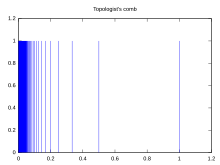Comb space
In mathematics, particularly topology, a comb space is a particular subspace of that resembles a comb. The comb space has properties that serve as a number of counterexamples. The topologist's sine curve has similar properties to the comb space. The deleted comb space is a variation on the comb space.


Formal definition[]
Consider with its standard topology and let K be the set . The set C defined by:
considered as a subspace of equipped with the subspace topology is known as the comb space. The deleted comb space, D, is defined by:
- .
This is the comb space with the line segment deleted.
Topological properties[]
The comb space and the deleted comb space have some interesting topological properties mostly related to the notion of connectedness.
1. The comb space is an example of a path connected space which is not locally path connected.
2. The deleted comb space, D, is connected:
- Let E be the comb space without . E is also path connected and the closure of E is the comb space. As E D the closure of E, where E is connected, the deleted comb space is also connected.
3. The deleted comb space is not path connected since there is no path from (0,1) to (0,0):
- Suppose there is a path from p = (0, 1) to the point (0, 0) in D. Let ƒ : [0, 1] → D be this path. We shall prove that ƒ −1{p} is both open and closed in [0, 1] contradicting the connectedness of this set. Clearly we have ƒ −1{p} is closed in [0, 1] by the continuity of ƒ. To prove that ƒ −1{p} is open, we proceed as follows: Choose a neighbourhood V (open in R2) about p that doesn’t intersect the x–axis. Suppose x is an arbitrary point in ƒ −1{p}. Clearly, f(x) = p. Then since f −1(V) is open, there is a basis element U containing x such that ƒ(U) is a subset of V. We assert that ƒ(U) = {p} which will mean that U is an open subset of ƒ −1{p} containing x. Since x was arbitrary, ƒ −1{p} will then be open. We know that U is connected since it is a basis element for the order topology on [0, 1]. Therefore, ƒ(U) is connected. Suppose ƒ(U) contains a point s other than p. Then s = (1/n, z) must belong to D. Choose r such that 1/(n + 1) < r < 1/n. Since ƒ(U) does not intersect the x-axis, the sets A = (−∞, r) × and B = (r, +∞) × will form a separation on f(U); contradicting the connectedness of f(U). Therefore, f −1{p} is both open and closed in [0, 1]. This is a contradiction.
4. The comb space is homotopic to a point but does not admit a deformation retract onto a point for every choice of basepoint.
See also[]
- Connected space
- Hedgehog space
- Infinite broom
- List of topologies
- Locally connected space
- Order topology
- Topologist's sine curve
References[]
- James Munkres (1999). Topology (2nd ed.). Prentice Hall. ISBN 0-13-181629-2.
- Kiyosi Itô (ed.). "Connectedness". Encyclopedic Dictionary of Mathematics. Mathematical Society of Japan. Cite journal requires
|journal=(help)
- Topological spaces
- Trees (topology)


![(\{0\} \times [0,1] ) \cup (K \times [0,1]) \cup ([0,1] \times \{0\})](https://wikimedia.org/api/rest_v1/media/math/render/svg/1840c5c3f77daef5355824188b1cc18ab96ebd57)
![{\displaystyle (\{0\}\times \{0,1\})\cup (K\times [0,1])\cup ([0,1]\times \{0\})}](https://wikimedia.org/api/rest_v1/media/math/render/svg/ec19e85061a67a5b9502b65e1897a8dd87a9b136)

![\{0\} \times (0,1]](https://wikimedia.org/api/rest_v1/media/math/render/svg/01c9697d05fbb7c7c383fea878ae14a4c7849e77)

